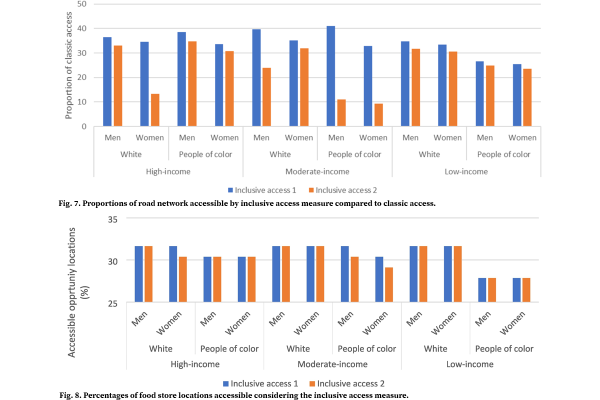In a new paper in the journal, Computers Environment and Urban Systems, former CURA GRA Amrita Kar, CURA Associate Director Ningchuan Xiao, CURA Director Harvey Miller, and CURA Faculty Affiliate Huyen Le, introduce a new inclusive accessibility concept.
Abstract:
Existing accessibility measures mainly focus on the physical limitations of travel and ignore travelers' perceptions, behavior, and socio-economic differences. By integrating approaches in time geography and travel behavior, this study introduces a bottom-up inclusive accessibility concept that aggregates individual-level travel perceptions across socio-economic groups to evaluate their multimodal access to opportunities. We classify accessibility constraints into hard constraints (physical space-time limitations to travel) and soft constraints (perceptual factors influencing travel, such as safety perceptions, comfort, and willingness to travel). We categorize travelers into 12 mutually exclusive socio-economic groups from a mobility survey dataset of 477 travelers. We apply a support vector regressor-based ensemble algorithm to estimate network-level walking perception scores as soft constraints for each social group. We derive group-specific inclusive accessibility measures that consider space-time limitations from transit and sidewalk networks as hard constraints and minimize the group-specific soft constraint to a certain threshold. Finally, we demonstrate the effectiveness of group-specific inclusive accessibility by comparing it with the classic access measure. Our study provides scientific evidence on how people of varying socio-economic statuses perceive the same travel environment differently. We find that socio-economically disadvantaged communities experience higher mobility barriers and lower accessibility while walking and using transit in Columbus, OH. Our study demonstrates a transition from person- to place-based accessibility measures by sequentially quantifying mobility perceptions for individual travelers and aggregating them by social groups for a large geographic scale, making this approach suitable for equity-oriented need-specific transportation planning.
Authors:
Kar, A., Xiao, N., Miller, H., & Le, H. (2024). Inclusive accessibility: Analyzing socio-economic disparities in perceived accessibility. Computers, Environment and Urban Systems, 114. https://doi.org/https://doi.org/10.1016/j.compenvurbsys.2024.102202

